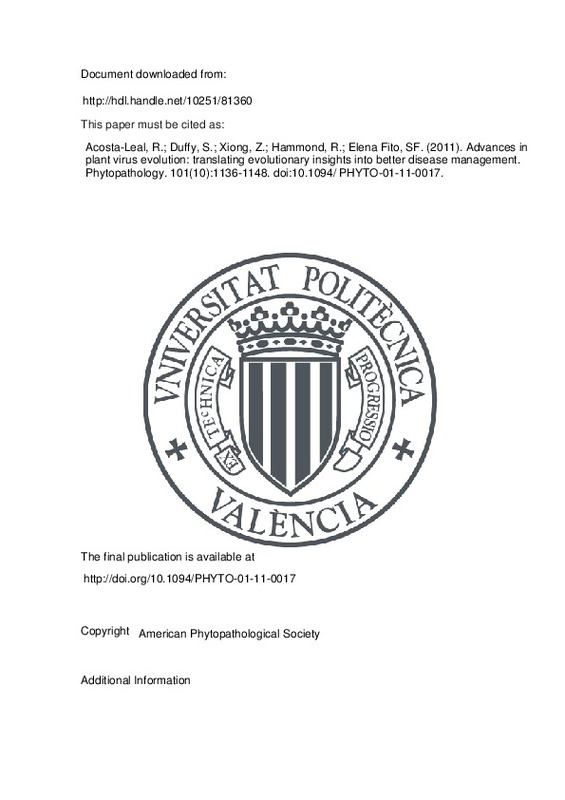JavaScript is disabled for your browser. Some features of this site may not work without it.
Buscar en RiuNet
Listar
Mi cuenta
Estadísticas
Ayuda RiuNet
Admin. UPV
Advances in plant virus evolution: translating evolutionary insights into better disease management
Mostrar el registro sencillo del ítem
Ficheros en el ítem
| dc.contributor.author | Acosta-Leal, R
|
es_ES |
| dc.contributor.author | Duffy, S
|
es_ES |
| dc.contributor.author | Xiong, Z
|
es_ES |
| dc.contributor.author | Hammond, R.W
|
es_ES |
| dc.contributor.author | Elena Fito, Santiago Fco
|
es_ES |
| dc.date.accessioned | 2017-05-18T08:49:48Z | |
| dc.date.available | 2017-05-18T08:49:48Z | |
| dc.date.issued | 2011-10 | |
| dc.identifier.issn | 0031-949X | |
| dc.identifier.uri | http://hdl.handle.net/10251/81360 | |
| dc.description.abstract | [EN] Recent studies in plant virus evolution are revealing that genetic structure and behavior of virus and viroid populations can explain important pathogenic properties of these agents, such as host resistance breakdown, disease severity, and host shifting, among others. Genetic variation is essential for the survival of organisms. The exploration of how these subcellular parasites generate and maintain a certain frequency of mutations at the intra- and inter-host levels is revealing novel molecular virus plant interactions. They emphasize the role of host environment in the dynamic genetic composition of virus populations. Functional genomics has identified host factors that are transcriptionally altered after virus infections. The analyses of these data by means of systems biology approaches are uncovering critical plant genes specifically targeted by viruses during host adaptation. Also, a next-generation re-sequencing approach of a whole virus genome is opening new avenues to study virus recombination and the relationships between intra-host virus composition and pathogenesis. Altogether, the analyzed data indicate that systematic disruption of some specific parameters of evolving virus populations could lead to more efficient ways of disease prevention, eradication, or tolerable virus plant coexistence. | es_ES |
| dc.language | Inglés | es_ES |
| dc.publisher | American Phytopathological Society | es_ES |
| dc.relation.ispartof | Phytopathology | es_ES |
| dc.rights | Reserva de todos los derechos | es_ES |
| dc.subject | Bottleneck | es_ES |
| dc.subject | Epistasis | es_ES |
| dc.subject | Fitness | es_ES |
| dc.subject | Metagenomics | es_ES |
| dc.subject | Mutation rate | es_ES |
| dc.subject | Recombination | es_ES |
| dc.subject | Robustness | es_ES |
| dc.subject | Transcriptome | es_ES |
| dc.title | Advances in plant virus evolution: translating evolutionary insights into better disease management | es_ES |
| dc.type | Artículo | es_ES |
| dc.identifier.doi | 10.1094/ PHYTO-01-11-0017 | |
| dc.rights.accessRights | Abierto | es_ES |
| dc.contributor.affiliation | Universitat Politècnica de València. Instituto Universitario Mixto de Biología Molecular y Celular de Plantas - Institut Universitari Mixt de Biologia Molecular i Cel·lular de Plantes | es_ES |
| dc.description.bibliographicCitation | Acosta-Leal, R.; Duffy, S.; Xiong, Z.; Hammond, R.; Elena Fito, SF. (2011). Advances in plant virus evolution: translating evolutionary insights into better disease management. Phytopathology. 101(10):1136-1148. doi:10.1094/ PHYTO-01-11-0017 | es_ES |
| dc.description.accrualMethod | S | es_ES |
| dc.relation.publisherversion | http://doi.org/10.1094/PHYTO-01-11-0017 | es_ES |
| dc.description.upvformatpinicio | 1136 | es_ES |
| dc.description.upvformatpfin | 1148 | es_ES |
| dc.type.version | info:eu-repo/semantics/publishedVersion | es_ES |
| dc.description.volume | 101 | es_ES |
| dc.description.issue | 10 | es_ES |
| dc.relation.senia | 218201 | es_ES |
| dc.identifier.pmid | 21554186 |







![[Cerrado]](/themes/UPV/images/candado.png)

